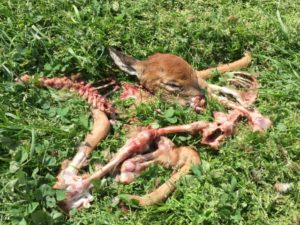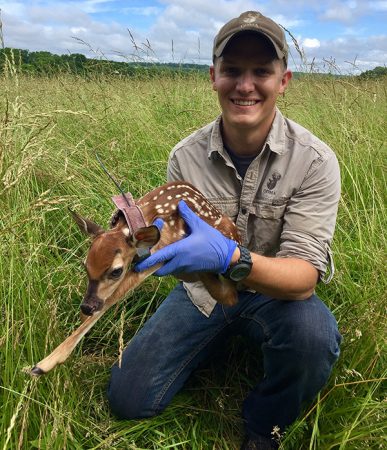Fortunately for whitetail fawns, the deer woods is the path less traveled in early summer. With turkey season in the history books and mushrooms long gone, only the most avid deer hunters put boots on the ground at this time of year. Since a motionless fawn is more safe from predators than a mobile one, the undisturbed forest floor is a benefit.
If you have had occasion to venture out during fawning season, you may well have jumped a fawn that was laying in plain sight, yet you didn’t notice it. Young whitetails have that spotted coat that blends well with almost any background and saves them from predators while their mother is away.
Cover can Help

According to research fawn born in areas with poor edge cover are twice as likely to be eaten by coyotes as those with good edge cover. Once, deer populations were doing so well that little attention was needed to the reproduction of the herd. That’s no longer the case as Kip Adams point out in this post from QDMA:
What came first – the doe or the fawn? Following the “chicken or the egg” analogy, you need a doe to produce a fawn, and you need a fawn to produce a doe. In reality, who came first is irrelevant as long as deer hunters and managers fully realize the importance of both. In the past, abundant deer densities and high fawn recruitment rates made the question less important as many areas in the whitetail’s range had a seemingly endless supply of deer. The situation is very different in many areas today. For example, the total antlerless deer harvest in the U.S. has dropped nearly 20 percent in the past decade. Fawn recruitment rates have dropped nearly 25 percent in the past 15 years, and fawn breeding rates have dropped over 50 percent since 2009. This all equates to an increasing importance on each fawn born this spring.
www.qdma.com/importance-good-fawning-cover









![The Best Deer Camp Chili [VIDEO] Deer Chili Ingredients, Tomatoes, Chili Spices](/wp-content/uploads/2015/10/Deer-Chili-Deer-Camp-Recipe-218x150.jpg)








![How to Call Elk Early in the Season [VIDEO]](/wp-content/uploads/2016/08/byers003-218x150.jpg)




![Idiots Disturb Hunter: How Would You Have Handled It? [VIDEO]](/wp-content/uploads/2015/10/DSC00110-e1474487693878-100x70.jpg)
![Albino Buck Shocked to Shed His Antlers [VIDEO]](/wp-content/uploads/2015/10/AlbinoDeer-100x70.jpg)